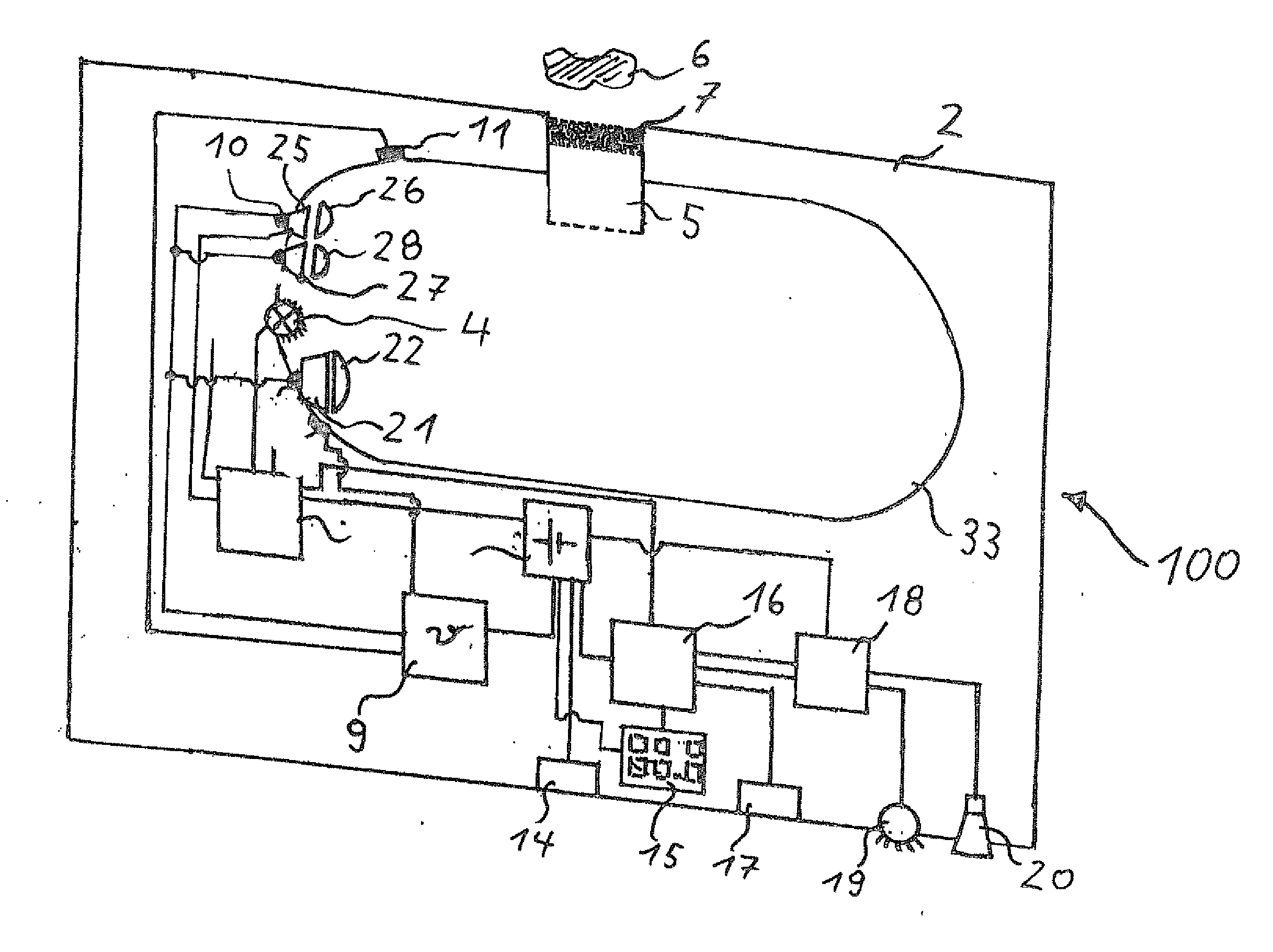This insensitivity to locally limited local contaminations arises from the fact that since the light is coupled from the
light source into the multireflection cuvettes in the undirected form, statistically locally random and varying reflections occur on the reflecting surfaces, both as single, double and even multiple reflections, before the light reaches the detector.
As a result, a locally limited local
contamination does not become an effective drawback for the
gas concentration measurement due to the statistically random and continuously varying reflections.
The overall size of the
cuvette is preset essentially by the space available for installing the gas-measuring device, but the space available for installation has its limitations for mobile gas-measuring devices concerning applicability for mobile applications.
The length of the measured section within the cuvette is limited, on the one hand, by the losses of light over the measured section itself and the light absorption by the target gas, and further essential limitations arise from the losses that occur due to the optical components and are due to the sensitivity of the detector used.
Such heating is not quite uncritical for using the measurement arrangement in areas with
explosion hazard.
The consequence of this is always an undesired,
high energy consumption for such a measurement arrangement.
Any increase in the
heat output during the operation is associated, however, with the drawback for mobile devices, of both an explosion-proof design and a non-explosion-proof design, that the quantity of
electric energy needed therefore must be carried along additionally in the form of an
energy storage device (batteries rechargeable batteries), which would result in a disadvantageous
excess weight for mobile applications, or that the available
operating time becomes shorter for mobile application without increasing the weight of the device, which is not realistic in case of the application scenarios of mobile gas-measuring devices in practical use.
The
explosion protection measures must be massively intensified for a measurement arrangement of an explosion-proof design, which is likewise associated again with drawbacks for the mobile use, besides a globally increased weight and volume, and additionally also has consequences for the construction and design of the protective element at the gas inlet.
This circumstance leads to a very massive construction for the protective element, which makes the access of gas difficult and causes disadvantageous changes in the measurement properties, and, in particular, the response characteristic in case of a
gas exchange, usually characterized by the so-called t10-90 time, is adversely effected by the longer
diffusion time of the gas through the protective element, which is now necessary, in such a way that the warning function of the measurement arrangement will not occur with a short
delay after a change in concentration in the measurement environment.
Further difficulties arise in the embodiment for the use of the measurement arrangement in areas with
explosion hazard, because the quantity of energy being carried along and the temperatures of elements in the measurement arrangements are limited by regulatory requirements.
Thus, it is not possible in a practical embodiment to prevent condensation nearly completely by means of increasing the
heat output while bringing about a marked reduction of the
relative humidity of the air in the measuring cuvette to values between 5% and 10% for both a measuring cuvette of non-explosion-proof design and a measuring cuvette of an explosion-proof design.
The consequence of this is that these wavelengths (2,215 nm, 2,300 nm, 2,385 nm) are unsuitable for a measurement arrangement designed as a
point detector for the measurement of alkanes by means of a cuvette, whose effective
optical path length is markedly shorter than 30 cm due to the overall size.
This permanent operating situation determines the measurement conditions for the measurement properties of the measurement arrangement over rather long periods of time
ranging from months to years as a measurement condition with the continuous presence of
atmospheric humidity in the measuring cuvette, and only the formation of condensation and droplets of water on the walls of the cuvette and the optical components, such as lenses, filters and mirrors can be prevented by heating, but the continuous presence of
atmospheric humidity at variable and unknown concentrations cannot.
The effect of these environmental effects, especially of the continual, further supply of
atmospheric humidity into the cuvette by the crystalline hygroscopic salt film, cannot be compensated by heating alone, especially for a measurement arrangement of an explosion-proof design in scenarios of use such as
offshore drilling platforms or onboard ships.
The continual penetration of atmospheric
humidity into the cuvette due to the hygroscopic effect of the fine crystalline salt films cannot be fully compensated even for a measurement arrangement of a non-explosion-proof design by changing the heating of the detector and / or cuvette, e.g., by increasing the
heat output or by raising the
heating temperature or even by a cyclically performed heating of the entire measurement arrangement.
These environmental effects likewise cannot be fully compensated either by the use of additional sensors, such as temperature,
moisture and pressure sensors in the cuvette or at the detectors.
 Login to View More
Login to View More 


